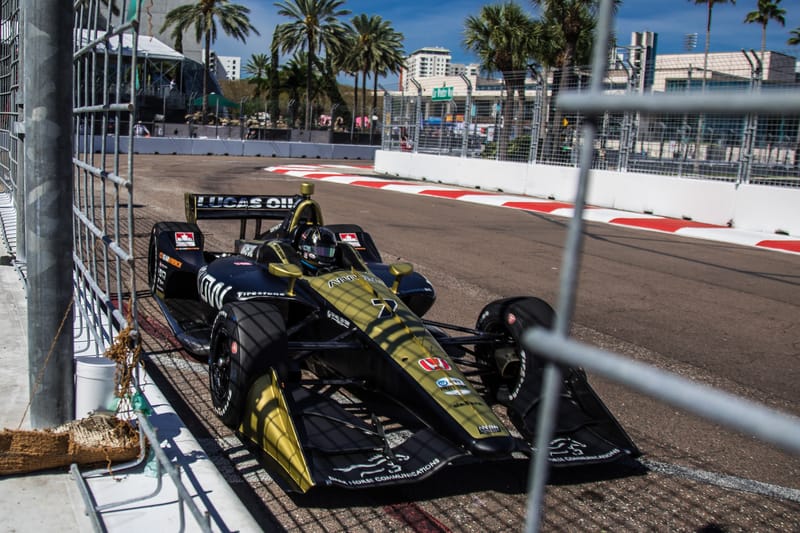Marcus Ericsson has stated that his retirement from his first NTT IndyCar Series race was “a shame” after having shown glimpses of promising pace throughout the Grand Prix of St. Petersburg race weekend. Ericsson was forced to retire his #7 Arrow Schmidt Peterson Honda mid-way through the race after the car suffered a punctured radiator.
After spending multiple tests getting used to his new habitat, former Formula 1 driver Ericsson was ready for his IndyCar debut at the Grand Prix of St. Petersburg, with the event getting underway on Friday with the first two practice sessions.
For the first session, Marcus, along with his fellow rookies on the grid, was given an extra set of Firestone tyres to help acclimatize to the circuit and the cars. Ericsson put the extra rubber to good use, spending most of the forty-five-minute session on the top of the leaderboard. His lap time of 1:02.0811 was fairly decent given the track conditions, but ultimately he would end the session in third place, behind fellow rookie Felix Rosenqvist and Andretti Autosport‘s Ryan Hunter-Reay.
Ericsson would not feature inside the top ten in either second practice or Saturday’s final practice, with the team instead opting to focus on getting as many laps completed as possible. As a result, Ericsson would enter qualifying with fifty-eight laps under his belt; just over half of Sunday’s race distance of 110-laps.
After the opening two practice sessions, Ericsson said in an interview with RACER that he did not expect to be as fast as he was in the first session and that his early running had reaffirmed his happiness to be racing in a series where he could have “real competition” compared to Formula 1; where only a handful of cars can take regularly take a win.
“It felt good.” Ericsson told RACER on Friday, “I was quicker than I expected, but a good start,” said the 28-year-old who is driving for Arrow SPM Racing in 2019. “This is why I came here, to get back to real competition.
“I spent five years in F1 driving hard and waiting on something good to happen but I wound up racing my teammate and that was very tough mentally. But this is why you race and it was big-time exciting today.”
Marcus would go on to liken the short street circuit at St. Petersburg to two former street circuits that he previously raced at in Formula 1.
“I like the track — it’s very technical,” Marcus said, “It reminds me a little of Monaco and Baku because you have to be very precise but it’s fun. [I] just like being in this car.”

Credit: Craig Robertson / Courtesy of Race Photography
Qualifying on Saturday did not go how Ericsson would have hoped. Ericsson went out in the second group in the first round of qualifying, which thankfully meant that he was not hindered by the pair of red flags that cost many drivers a chance of putting in a competitive lap. Sadly, however, Marcus would instead make a mistake on both of his fast laps, which would mean that he would fail to advance into round two and would, therefore, start the race down in eighteenth place.
Marcus would detail his issues in the first round in post-session interviews:
“It was a disappointing qualifying session for us.” Ericsson said on Saturday, “On the first set of tires, the primaries [Firestone black tires], I had a big lockup on my first timed lap, so that made that whole run pretty compromised because of it. I was struggling with that to get a good reference for the [Firestone alternate tires] reds. Then on the reds, I was on a decent lap, but I brushed the wall quite hard in Turn 9, which sort of bent the car a bit and I couldn’t improve from there.”
“Disappointing to go out straight away in the first round, but it’s still a new day tomorrow and we have a good chance with the Arrow cars.”
At the start of the race on Sunday, Ericsson got off to a clean and composed start. The Swedish driver maintained position in the early laps, but he soon began to make moves up the order. Just after the half-way point, Marcus was running inside the top ten in the ninth position, but that was where his race would be derailed.
Ericsson’s pace in the #7 car would begin to slow shortly after lap fifty, with Arrow Schmidt Peterson calling him into the pits at the end of lap fifty-four. The team would check the car over to try and diagnose any potential problems, with the cause eventually being found in the form of a punctured radiator. The issue was such that Ericsson was not able to return to the race track; a sad way for his debut IndyCar race to end. In the end, Ericsson would be classified in twentieth place out of twenty-four entrants.
“It was a great race up until the end.” a disappointed Ericsson said post-race, “We started quite far back, farther back than what we think we should’ve started. It was going well and we were well inside the top 10 when we had the problem.
“Looking at what’s happening now [at the time of the interview, while the race was going on], we were definitely going for a top eight in the Arrow car. It was just a shame because it was a really great race up until then.”
Ericsson will be hoping for a change of fortunes at the second round of the season at the Circuit of the Americas in just under two weeks time. Marcus will enter the event not only with experience from pre-season testing at the venue in Austin, Texas but also with the prior experience of four previous Formula 1 Grand Prix races at the circuit.
The 2019 IndyCar Classic at COTA will take place on Sunday, March 24.



